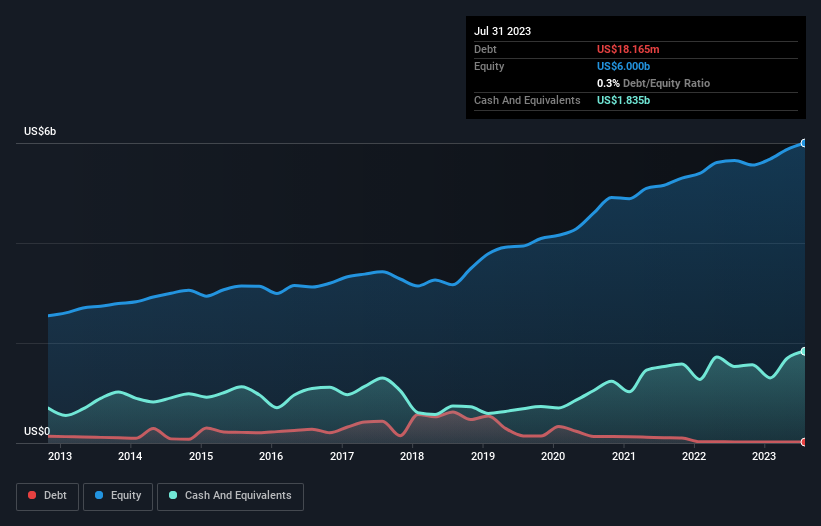
Howard Marks put it nicely when he said that, rather than worrying about share price volatility, 'The possibility of permanent loss is the risk I worry about... and every practical investor I know worries about.' So it seems the smart money knows that debt - which is usually involved in bankruptcies - is a very important factor, when you assess how risky a company is. We can see that Synopsys, Inc. (NASDAQ:SNPS) does use debt in its business. But is this debt a concern to shareholders?
When Is Debt A Problem?
Debt and other liabilities become risky for a business when it cannot easily fulfill those obligations, either with free cash flow or by raising capital at an attractive price. If things get really bad, the lenders can take control of the business. However, a more common (but still painful) scenario is that it has to raise new equity capital at a low price, thus permanently diluting shareholders. By replacing dilution, though, debt can be an extremely good tool for businesses that need capital to invest in growth at high rates of return. When we think about a company's use of debt, we first look at cash and debt together.
See our latest analysis for Synopsys
What Is Synopsys's Debt?
As you can see below, Synopsys had US$18.2m of debt at July 2023, down from US$22.0m a year prior. However, its balance sheet shows it holds US$1.83b in cash, so it actually has US$1.82b net cash.

A Look At Synopsys' Liabilities
The latest balance sheet data shows that Synopsys had liabilities of US$2.73b due within a year, and liabilities of US$1.19b falling due after that. Offsetting this, it had US$1.83b in cash and US$936.7m in receivables that were due within 12 months. So it has liabilities totalling US$1.15b more than its cash and near-term receivables, combined.
Having regard to Synopsys' size, it seems that its liquid assets are well balanced with its total liabilities. So it's very unlikely that the US$75.3b company is short on cash, but still worth keeping an eye on the balance sheet. Despite its noteworthy liabilities, Synopsys boasts net cash, so it's fair to say it does not have a heavy debt load!
On the other hand, Synopsys saw its EBIT drop by 2.6% in the last twelve months. That sort of decline, if sustained, will obviously make debt harder to handle. The balance sheet is clearly the area to focus on when you are analysing debt. But ultimately the future profitability of the business will decide if Synopsys can strengthen its balance sheet over time. So if you want to see what the professionals think, you might find this free report on analyst profit forecasts to be interesting.
But our final consideration is also important, because a company cannot pay debt with paper profits; it needs cold hard cash. While Synopsys has net cash on its balance sheet, it's still worth taking a look at its ability to convert earnings before interest and tax (EBIT) to free cash flow, to help us understand how quickly it is building (or eroding) that cash balance. Over the last three years, Synopsys actually produced more free cash flow than EBIT. That sort of strong cash generation warms our hearts like a puppy in a bumblebee suit.
Summing Up
We could understand if investors are concerned about Synopsys's liabilities, but we can be reassured by the fact it has has net cash of US$1.82b. The cherry on top was that in converted 144% of that EBIT to free cash flow, bringing in US$1.6b. So we don't think Synopsys's use of debt is risky. Over time, share prices tend to follow earnings per share, so if you're interested in Synopsys, you may well want to click here to check an interactive graph of its earnings per share history.
If you're interested in investing in businesses that can grow profits without the burden of debt, then check out this free list of growing businesses that have net cash on the balance sheet.
New: Manage All Your Stock Portfolios in One Place
We've created the ultimate portfolio companion for stock investors, and it's free.
• Connect an unlimited number of Portfolios and see your total in one currency
• Be alerted to new Warning Signs or Risks via email or mobile
• Track the Fair Value of your stocks
Have feedback on this article? Concerned about the content? Get in touch with us directly. Alternatively, email editorial-team (at) simplywallst.com.
This article by Simply Wall St is general in nature. We provide commentary based on historical data and analyst forecasts only using an unbiased methodology and our articles are not intended to be financial advice. It does not constitute a recommendation to buy or sell any stock, and does not take account of your objectives, or your financial situation. We aim to bring you long-term focused analysis driven by fundamental data. Note that our analysis may not factor in the latest price-sensitive company announcements or qualitative material. Simply Wall St has no position in any stocks mentioned.
About NasdaqGS:SNPS
Synopsys
Provides electronic design automation software products used to design and test integrated circuits.
Flawless balance sheet with solid track record.


